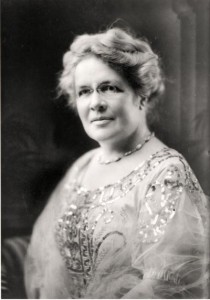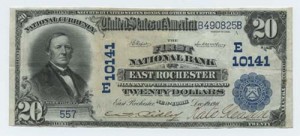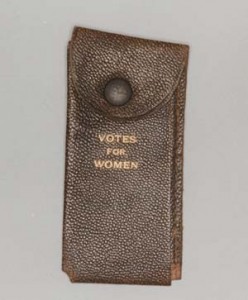 Born November 24/25, 1865
Born November 24/25, 1865
Birthplace Rochester, NY
Died January 9, 1933
Grave Site Riverside Cemetery, Rochester, NY
Contribution Businesswoman, developer and philanthropist
Quotation “Possum Volo” (a Latin expression meaning “I can, if I will.”)
Kate Gleason was born in Rochester, New York on November 24/25, 1865* to William and Ellen (McDermot) Gleason. Her parents were Irish immigrants. Her father was a mechanic and a toolmaker. Both of her parents favored women’s rights. Kate Gleason’s mother, Ellen, was born near Belfast, Ireland, in 1844. She came to the United States at the age of four, and married William Gleason in 1863. Ellen Gleason was a staunch suffragist and friend of Susan B. Anthony.
Kate Gleason had two brothers and one sister, as well as a half-brother from her father’s previous marriage. She was baptized a Roman Catholic, although she professed no formal religious affiliation as an adult. She was educated at both parochial and public schools, including Nazareth Convent in Rochester, New York.
In 1874, Gleason’s father designed a machine that automatically planed beveled gears. This machine allowed for great precision. Prior to its development, the gears had to be cut by hand, and standardization could not be achieved. Its development and continuous refinement over the years were important to the automobile industry, which ultimately relied on standardization (and mass production) for its success.
In 1877, Gleason’s half-brother died, and she began helping out in the office of her father’s tool shop. By 1880, when she was fourteen and in high school, she had become the bookkeeper for the family business.
Gleason graduated from high school in 1884 and went to Cornell University, the first woman to enter its engineering program. However, her father soon found that he could not afford to replace her in his tool shop, and she had to leave before the end of her freshman year in order to resume work in the family business. She returned to Cornell in 1888, but again left before the year was over. Except for some work as a part-time student at Rochester’s Mechanics Institute (later Rochester Institute of Technology), this was the extent of Gleason’s formal education.
Gleason continued to keep the books for her father’s increasingly prosperous company, which is now located at 1000 University Avenue in Rochester. Her role was formally acknowledged in her appointment as the Gleason Tool Company’s Secretary/Treasurer when the business was incorporated in 1890. She also served as the company’s sales representative, traveling widely throughout the United States and Europe. During her first European trip in the 1890s, she promoted the business to companies in France, Germany, England, and Scotland. In 1900, she acted as the company’s representative at the Paris Exposition. Gleason is in fact widely credited with helping the family’s small company grow into a nationally prominent producer of gear-cutting machinery.
Gleason left her family’s business in 1913 after numerous disputes with her brother and others. On January 1, 1914, she was appointed receiver in bankruptcy for the Ingle Machine Company of East Rochester, New York. Most reports state that she was the first woman to be appointed to such a position by a bankruptcy court. She reorganized the company and within a year and a half, its debts were paid. When she returned the business to its stockholders, it was a profitable enterprise.
 In 1918, Gleason was appointed president of the First National Bank of East Rochester.** She assumed the role when the bank’s president, H.C. Eyer, left the position in order to participate in the war effort. She acted as the bank’s president for the duration of World War I.
In 1918, Gleason was appointed president of the First National Bank of East Rochester.** She assumed the role when the bank’s president, H.C. Eyer, left the position in order to participate in the war effort. She acted as the bank’s president for the duration of World War I.
During her term at the bank, Gleason started eight businesses and became interested in construction and development. One of the businesses, the Concrest Community, built affordable houses for working people in East Rochester. Gleason was able to contain the cost of these houses because the company used mass production techniques similar to those that were made possible in the automobile industry by her father’s invention. The homes were made of poured concrete with standardized designs, and built by unskilled labor. They still stand and are lived in today.
Gleason’s interest in construction and development continued after she left her post at the bank. She helped to rebuild the French village of Septmonts after World War I, constructing a public library and a movie theater there and restoring the village’s twelfth century castle tower. She vacationed every autumn in the restored castle.
In the 1920s, Gleason toured California to study adobe buildings. In 1924, she was asked to advise Berkeley, California on their attempts to rebuild after a fire. During the late 1920s, she began a project to create poured concrete homes in Sausalito, California. During the same period she also began to develop an artist and writers’ community in the vicinity of Beaufort, South Carolina, where she spent her winters. Unfortunately, she died before this project was completed.
Gleason claimed to have been influenced in methods of advertising and promotion by her mother’s friend, Susan B. Anthony. Anthony told Gleason at one point to take more care with her appearance, and Gleason took this advice to heart. She told Helen Christine Bennett of The American Magazine that as a result of Anthony’s words:
…I went in for extremely feminine attire….I had my hair dressed and wore violets in my muff and had some soft, frivolous gowns made.
Anthony’s advice seems to have paid off. Gleason goes on to say:
This attention to dress repaid me well. Some of my customers spoke to me twenty years after about a certain dress or hat that I wore when I made a sale. I learned to value clothes, to love clothes and to use clothes.
Gleason also credited Anthony with teaching her that any publicity is ultimately good publicity:
Susan B. Anthony…had impressed one fact upon me while I was growing up. ‘Any advertising is good,’ she said. ‘Get praise if possible, blame if you have to. But never stop being talked about.’
Gleason was a supporter of women’s suffrage, if not an activist. In February, 1906 she and her father hosted Susan B. Anthony’s final birthday party at their home. Ida Husted Harper quotes a contemporary newspaper as stating that the event was a “brilliant reception,” with rooms full of “representative people of the community,” “[d]elightful music…furnished by an orchestra of women,” “refreshments…served throughout the evening,” and “[a]ddresses highly eulogistic of the honored guest….”
An account of the 1912 National America Woman Suffrage Association Convention mentions Gleason as having promised $1,200 to the work of the suffrage movement, one of its largest pledges. Gleason’s own personal writings note the contributions by her and her father to the suffrage cause.
 In addition to her professional accomplishments and her support of women’s suffrage, Gleason was also prominent in a number of professional organizations. She was among the first women members of the Verein Deutscher Ingenieure (1913), the American Society of Mechanical Engineers (of which she is said to have become the first full woman member in 1914), and the Rochester Engineering Society (1916). She was also involved in area community organizations. In 1916 she joined the Rochester Chamber of Commerce and in 1919 she, with Assistant Superintendent of Parks John Dunbar, helped to organize the Rochester Rose Society.
In addition to her professional accomplishments and her support of women’s suffrage, Gleason was also prominent in a number of professional organizations. She was among the first women members of the Verein Deutscher Ingenieure (1913), the American Society of Mechanical Engineers (of which she is said to have become the first full woman member in 1914), and the Rochester Engineering Society (1916). She was also involved in area community organizations. In 1916 she joined the Rochester Chamber of Commerce and in 1919 she, with Assistant Superintendent of Parks John Dunbar, helped to organize the Rochester Rose Society.
Gleason died of pneumonia in Rochester, New York on January 9, 1933. She was buried in Riverside Cemetery. She left an estate of $1.4 million, much of it bequeathed to philanthropic causes. The Rochester Institute of Technology was a beneficiary, and the city of Rochester received $100,000 for a local history alcove at the public library. More than one million dollars was used to establish the Kate Gleason Fund, formed for the benefit of the employees of the Gleason works and other charitable enterprises.
NOTES:
The Women’s Suffrage Digitization Project is indebted to Karl Kabelac and Jan Gleason, who reviewed early drafts of this biography and provided corrections as well as additional information on the subject. Kabelac provided copies of many newspaper articles about Kate Gleason, and Jan Gleason provided information from Kate Gleason’s personal papers.
*Most published sources state that Kate Gleason was born on November 25, 1865. However, Jan Gleason states that she was born on November 24, 1865. Jan Gleason notes that Kate’s “brother, Jim, was born on Nov. 25 and that may have contributed to the confusion in subsequent reports.”
**Again, most published sources state that the date of Gleason’s appointment was 1917. Karl Kabelac, however, states that Gleason was actually appointed in August of 1918. His assertion is supported by many newspaper articles announcing her appointment and written in August of 1918. Citations for these newspaper articles appear below.
Bibliography of Suggested Books & Articles
- American Society of Mechanical Engineers (ASME), “[Obituary of] Kate Gleason (1865-1933,” Transactions, 1934, p. RI-19.
- Bennett, Helen Christine, “Kate Gleason’s Adventures in a Man’s Job,” interview appearing in American Magazine, Oct. 28, pp. 42-43, 158-75.
- Chappell, Eve, “Kate Gleason’s Careers,” interview appearing in Woman Citizen, n.s., 10, (Jan. 1926).
- Conners, Mary, East Rochester, New York: One Hundred Years of History, 1897-1997, Dallas, Texas: Taylor Publishing Company, nd [1999?].
- Dow, Harriet Brown, “Influence of Women in the Life of Rochester, in Centennial History of Rochester, New York, Volume II, “Homebuilders,” Edward R. Foreman, comp. and ed., Rochester, NY: 1932. (This has information on Rochester Rose Society)
- “East Rochester Has First of Women Bank Presidents,” The Rochester Herald, Sunday, August 18, 1918, p. 10.
- Frank, Irene M. and David M. Brownstone, Women’s World: A Timeline of Women in History, HarperCollins Publishers, 1995.
- Garraty, John A. and Mark C. Carnes, eds., American National Biography, New York: Oxford University Press, 1999, v. 9, pp. 111-112, entry by Milton Berman.
- Gleason, Jan, Email Correspondence to Anne Filiaci, April 23, 2000.
- Harper, Ida Husted, Life and Work of Susan B. Anthony, 3 vols. v. III, Indianapolis: The Hollenbeck Press, 1908. (Page 1382 contains a description of Susan B. Anthony’s 86th birthday party.)
- Harper, Ida Husted, ed., History of Woman Suffrage, v. V. N.s., National American Woman Suffrage Association, 1922 (Reprint, NY: Source Book Press, 1970. Pages 340-1 note that Kate Gleason gave a pledge of $1200).
- James, Edward T., Janet Wilson James and Paul S. Boyer, eds., Notable American Women, 3 vols., Cambridge, Mass.: Belknap Press (Harvard University), 1971. (Gleason’s biography appears in v. II, pp. 51-52.)
- Kabelac, Karl, “Kate Gleason, National Bank President,” Paper Money, Vol. XXXVIII, No. 3, Whole No. 201 (May/June 1999), pp. 67-70.
- “Kate Gleason,” Business Strategies Newspaper, December 1999.
- “Kate Gleason Dies; Made Name for Self In Business World,” Rochester Times Union, Monday, January 9, 1933.
- McKelvey, Blake, “Susan B. Anthony,” Rochester History, Vol. VII, No. 2 (April 1945).
- “Miss Gleason President of East Rochester Bank,” Rochester Democrat & Chronicle, Sunday August 18, 1918, p. 27.
- “Miss Kate Gleason Chosen President of National Bank,” Rochester Times Union, Monday, August 19, 1918, p. 7.
- “Mortuary Record,” (for Ellen Gleason), The Rochester Herald, Friday, February 28, 1896, p. 6.
- “Mrs. Ellen M. Gleason: Death of a Well-Known Woman of Consumption,” Rochester Union and Advertiser, Thursday, Feb. 27, 1896, p. 7.
- New York Times, Jan. 10, 1933 has an obituary. (Provisions of will appear Jan 15/1933)
- “Noted Woman Engineer Passes,” Rochester Evening Journal and the Post Express, Monday, January 9, 1933, p. 1.
- Osborne, Alan, “Kate Gleason,” in Studies in Local History, Tall Tales, Folklore and Legend of Upstate New York, [Rochester, NY] s.n., 1986 (Essays in research for Professor William H. Siles class “Studies in Local History,” available at RMSC.)
- Read, Phyllis J. and Bernard L. Witlieb, The Book of Women’s Firsts: Breakthrough Achievements of Almost 1,000 American Women, Random House, 1992.
- Rochester Democrat and Chronicle (Jan 10, 1933) has an obituary. (Provisions of will appear Jan. 14, 1933.)
- RIT archives has photos, newsclippings and articles.
- Sherr, Lynn and Jurate Kazickas, Susan B. Anthony Slept Here: A Guide to American Women’s Landmarks, New York: Times Books (Random House), c1976, 1994.
- Who Was Who in America: A Companion Volume for Who’s Who in America, vol. I, 1897-1942, Chicago: Marquis, 1942.
- “Woman Bank Head in East Rochester,” The Post Express, Rochester, NY, Monday, August 19, 1918, p. 3.
Bibliography of Suggested Web Sites
- The First Lady of Gearing
- Kate Gleason on Distinguished Women of Past and Present
- Kate Gleason on Encyclopaedia Britannica